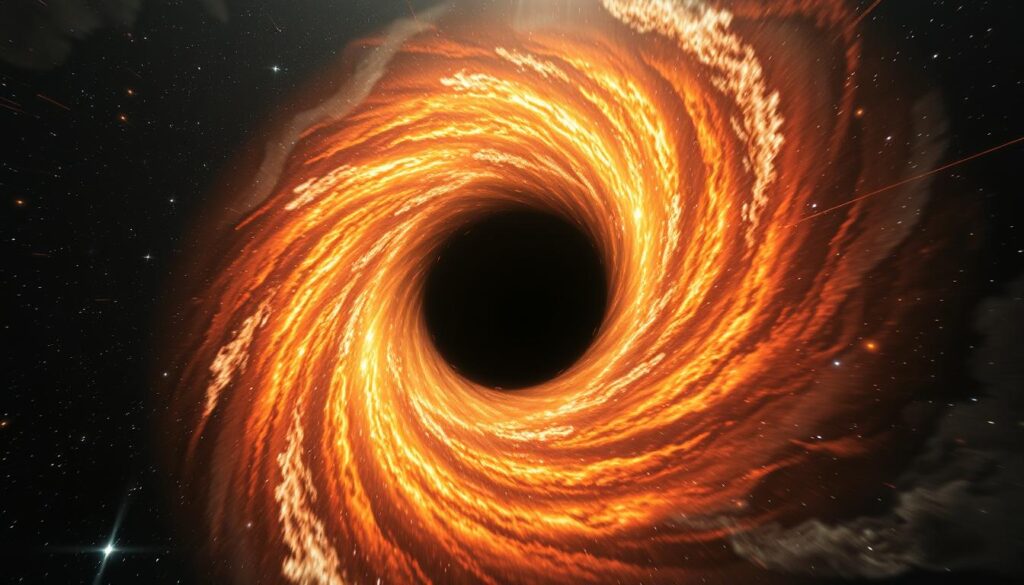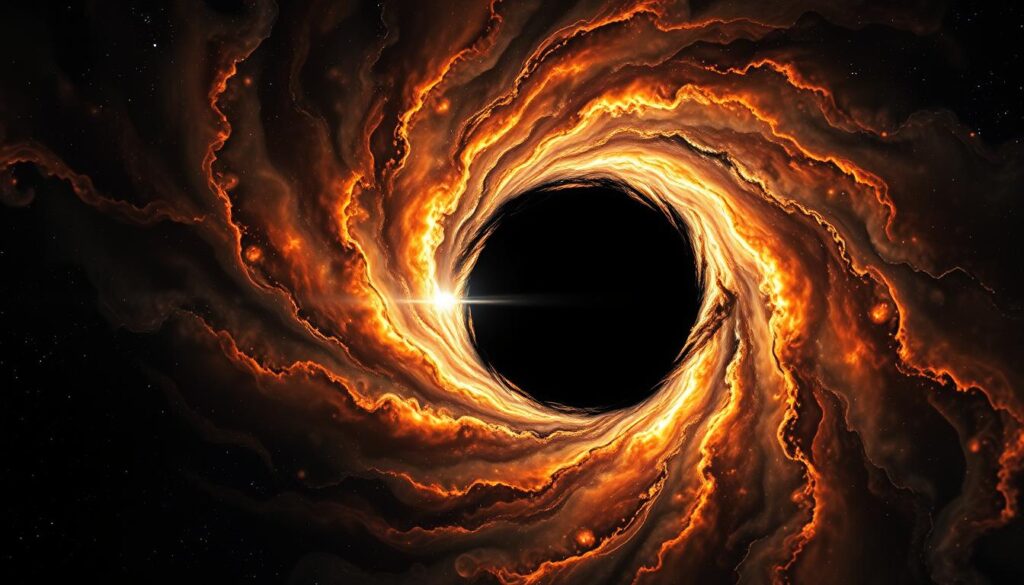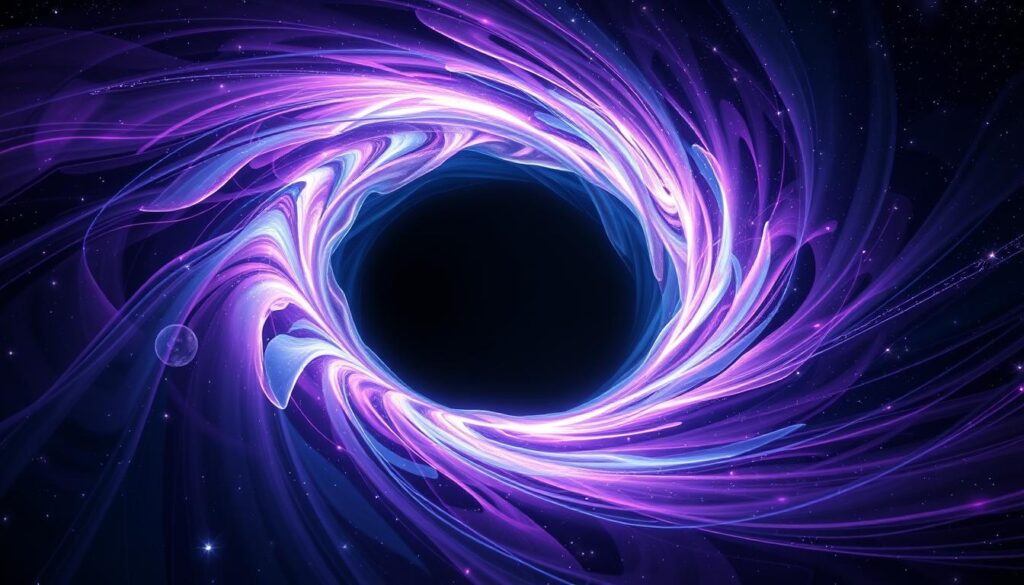
Imagine a cosmic phenomenon so powerful that not even light can escape its gravitational pull. Black holes represent some of the most intriguing mysteries in our universe. When scientists explore what are black holes, they encounter extraordinary cosmic objects that challenge our understanding of space and time.
Your journey into the world of black holes begins here. A black hole definition extends beyond simple astronomical terminology. These celestial giants are regions of spacetime where gravity becomes so intense that nothing can break free from their gravitational embrace. Researchers like Stephen Hawking have dedicated entire careers to understanding these remarkable cosmic structures.
From the heart of distant galaxies to the potential centers of our own Milky Way, black holes continue to fascinate scientists and space enthusiasts alike. Their complex nature reveals extraordinary insights into the fundamental workings of our universe.
Key Takeaways
- Black holes are extreme cosmic regions with immense gravitational power
- Not even light can escape a black hole’s gravitational pull
- Scientists continue to study these mysterious astronomical objects
- Black holes exist in various sizes across different galaxies
- Understanding black holes helps unlock universal mysteries
What Are Black Holes: Understanding the Cosmic Giants

Black holes represent some of the most mysterious and powerful objects in our universe. These cosmic giants are regions of space where gravity becomes so intense that nothing, not even light, can escape their gravitational pull. The black hole properties make them unique astronomical phenomena that challenge our understanding of physics.
At the heart of every black hole lies a black hole singularity – an infinitesimally small point of infinite density where the laws of physics break down. This extraordinary region warps space-time itself, creating a gravitational field so strong that it consumes everything within its event horizon. Imagine a cosmic vacuum cleaner so powerful that it swallows matter, energy, and even light without mercy.
You might wonder how such extreme objects form. Typically, black holes emerge when massive stars collapse at the end of their life cycles. Their immense gravitational force compresses matter into an incredibly compact space, creating a region where traditional physics no longer applies. Scientists continue to study these fascinating cosmic structures to unravel their complex mysteries.
“Black holes are where God divided by zero.” – Steven Wright
Understanding black holes helps us explore the fundamental nature of space, time, and gravity. Each discovery brings us closer to comprehending these extraordinary cosmic giants that continue to fascinate researchers and space enthusiasts worldwide.
The Fascinating Journey of Black Hole Formation

Black hole formation represents one of the most dramatic transformations in the universe. When massive stars reach the end of their life cycle, they undergo an extraordinary process that can result in the creation of these cosmic enigmas. Your understanding of black hole theory begins with recognizing how stellar evolution plays a crucial role in their birth.
During a star’s final stages, immense gravitational pressure causes its core to collapse. When a star significantly larger than our sun exhausts its nuclear fuel, it experiences a spectacular supernova explosion. The remaining stellar core, now incredibly dense, can compress into a black hole if its mass exceeds a critical threshold.
“In the cosmic dance of creation and destruction, black holes emerge as nature’s most extreme sculptors.” – Astrophysics Quarterly
Scientists have identified multiple scenarios for black hole formation. Stellar black holes emerge from massive star collapses, while supermassive black holes at galaxy centers develop through different mechanisms. Your exploration of black hole theory reveals these objects can grow by consuming surrounding matter, gradually increasing their mass and complexity.
Gravitational waves and advanced telescopes have revolutionized our understanding of how these cosmic giants form. Researchers continue to study the intricate processes that transform stellar remnants into regions where gravity becomes so intense that not even light can escape.
Inside the Event Horizon: Properties and Characteristics

When you approach a black hole’s event horizon, you enter a region where the laws of physics become incredibly strange. This boundary represents the point of no return for anything entering a black hole, including light itself. Black hole properties at the event horizon create a cosmic barrier that defies our normal understanding of space and time.
The event horizon acts like a cosmic trap. Gravity becomes so intense that nothing can escape once it crosses this invisible boundary. Imagine a cosmic whirlpool where the gravitational pull is so powerful that even light gets pulled inward. Scientists have discovered that black hole properties near the event horizon cause extreme time dilation, meaning time moves differently compared to regions outside the black hole.
One of the most mind-bending phenomena near a black hole event horizon is spaghettification. As you get closer to the boundary, gravitational forces would stretch your body into a long, thin shape – much like a piece of spaghetti. This process demonstrates the extreme physical conditions that exist at the edge of these cosmic giants.
The event horizon represents the ultimate boundary of our current scientific understanding, where the known rules of physics break down.
Researchers continue to explore these mysterious cosmic regions, pushing the boundaries of our knowledge about black hole properties. Each new discovery brings us closer to understanding these fascinating astronomical objects that challenge our perception of reality.
Types of Black Holes in Our Universe
When exploring what are black holes, you’ll discover they come in fascinating varieties. Black hole types range from tiny stellar remnants to massive cosmic giants lurking at the center of galaxies. Scientists have identified several distinct categories that help us understand these mysterious space phenomena.
Stellar-mass black holes represent the most common type. These form when massive stars collapse at the end of their life cycle. They typically weigh between 3 to 10 times the mass of our sun. These compact objects emerge from the dramatic death of enormous stars, representing a remarkable transformation in cosmic evolution.
Supermassive black holes present an entirely different scale of astronomical wonder. Found at the centers of most galaxies, including our Milky Way, these behemoths can contain millions or even billions of solar masses. Their immense gravitational pull influences entire galactic structures, making them critical to understanding cosmic dynamics.
Researchers have also proposed the existence of intermediate-mass and primordial black holes. Intermediate-mass black holes occupy a range between stellar and supermassive varieties, while primordial black holes might have formed during the universe’s earliest moments. These theoretical types continue to intrigue astrophysicists and expand our understanding of black hole types.
Each black hole type offers a unique window into the complex mechanisms of space and gravity.
Groundbreaking Discoveries in Black Hole Research
The world of black hole discovery has dramatically transformed in recent years. Scientists have made remarkable strides in black hole observation, pushing the boundaries of our cosmic understanding. In 2019, the Event Horizon Telescope team captured the first-ever direct image of a black hole’s event horizon, marking a pivotal moment in astronomical research.
Your understanding of these cosmic giants will be revolutionized by recent gravitational wave detections. The Laser Interferometer Gravitational-Wave Observatory (LIGO) has detected multiple black hole mergers, providing unprecedented insights into these mysterious space phenomena. These black hole observations have confirmed Einstein’s predictions about gravitational waves and opened new windows into understanding cosmic interactions.
Advanced technologies now allow researchers to track black hole movements with incredible precision. Sophisticated telescopes and quantum computing have enabled scientists to map black hole interactions across different galaxies. Each new black hole discovery reveals more about the complex nature of our universe, challenging previous scientific assumptions and expanding our cosmic knowledge.
“Every black hole observation is like solving a piece of the universal puzzle.” – Dr. Sheperd Doeleman, Event Horizon Telescope Director
The future of black hole research looks incredibly promising. Collaborative international projects continue to push technological boundaries, bringing us closer to understanding these remarkable cosmic structures that continue to captivate scientists and space enthusiasts worldwide.
The Role of Black Holes in Galaxy Formation
Black hole theory reveals a fascinating connection between these cosmic giants and the formation of galaxies. At the heart of most galaxies lies a supermassive black hole that plays a critical role in shaping galactic structures. You might be surprised to learn how these mysterious objects influence the evolution of entire cosmic neighborhoods.
When exploring black hole properties, scientists have discovered that these celestial phenomena are not just destructive forces. They act as powerful engines driving galactic dynamics. Supermassive black holes at galactic centers generate immense gravitational energy that can trigger star formation, regulate gas flow, and control the overall growth of their host galaxies.
Active galactic nuclei and quasars provide compelling evidence of black holes’ transformative power. These energetic regions demonstrate how black holes interact with surrounding stellar environments. The intense radiation and powerful jets emitted by these cosmic centers can push out or compress galactic material, ultimately determining the shape and structure of entire star systems.
Astronomers now understand that black holes are not isolated entities but integral components of galactic ecosystems.
Your understanding of the universe expands when you recognize the profound impact black holes have on cosmic architecture. From regulating star formation to influencing galactic mergers, these remarkable astronomical objects continue to challenge our perception of space and time.
Conclusion: The Future of Black Hole Studies
As you dive into the world of black hole observation, the horizon of scientific discovery continues to expand. Advanced telescopes and innovative research techniques are pushing the boundaries of our understanding, revealing intricate details about these cosmic phenomena. The James Webb Space Telescope and Event Horizon Telescope represent cutting-edge technologies that promise to unlock even more mysteries surrounding black holes.
Your journey through black hole discovery has highlighted the incredible complexity of these astronomical objects. Scientists are now developing more sophisticated computational models and gravitational wave detection methods that will provide unprecedented insights into black hole interactions. Researchers at institutions like LIGO and NASA are pioneering new approaches to studying these enigmatic cosmic giants.
The future of black hole studies looks incredibly promising. You can expect groundbreaking revelations that will challenge our current understanding of space, time, and fundamental physics. Emerging technologies and collaborative international research efforts are poised to transform our knowledge, potentially uncovering connections between black holes and other cosmic phenomena that we have yet to imagine.
As technology advances, your understanding of these celestial wonders will continue to grow. The mysteries of black holes remain a testament to human curiosity and our relentless pursuit of knowledge about the universe. Each new discovery brings us closer to comprehending the profound secrets hidden within these extraordinary cosmic structures.






